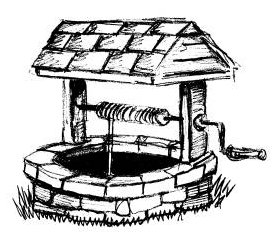
Ding, dong, bell!
Pussy's in the well.
What image do these words evoke for you? Maybe none at all, unless you know the English nursery rhyme. And if you do know it, then you probably have a picture in your mind of a well a bit like the one here.
The problem with words is that they carry with them associations - pictures in our mind. These pictures can vary when the words are used in different ways. Any visitors who go to Tunbridge Wells in the south of England will be disappointed if they expect to find the streets lined with the kind of well illustrated! And if the dormouse's treacle well in Alice in Wonderland conjures up this image (misleadingly, as it happens), an oil well certainly doesn't!
This is a big problem for translators. Staying with wells for a moment, a German speaker might call the structure in the picture a Brunnen. But the same word, Brunnen, is used for the fountains in the middle of Berne's streets, which are certainly not wells. And an oil-well is not an Ölbrunnen, but an Ölquelle. And a Quelle might be a spring, if water comes out of it, or a source if something else comes out of it. And so I could go on for pages! (Perhaps even arriving at the word 'font', which is worth an article to itself.)
Well, fountain, spring, source (and let's add cistern for good measure), all are places where we can go and get our supply of the water we need to live. Of course, we don't do this nowadays. We use taps. And there is another problem for translators, for in Bible times, taking a pitcher to the fountain fulfilled the same function as turning on the tap.
Water was, and is, an important commodity in the Middle East, and the writers of the Bible used a number of words for the place where people went to get it. It doesn't matter too much if the same word may at one time mean a shallow cavity where you rolled away a stone to water your sheep, at another an abundant spring gushing out of a hillside, or again, a deep hole with water at the bottom.
The well at Sychar, near Shechem, where Jesus asked the Samaritan woman for a drink before offering her "living water", was deep (John 4:11). If it is the well which is known today as "Jacob's Well", the water in it was spring water, cool and fresh, but not as refreshing and abundant as the water Jesus offered. "Those who drink of the water that I will give them will never be thirsty. The water that I will give will become in them a spring of water gushing up to eternal life." (John 4:14)
To make sense, English versions of the Bible have had to use two words, 'well' and 'spring', to translate the same Greek word, pege. A well is a hole you dig, a spring is something that comes by itself. But when we read our Bible, we need to think what these two things have in common.
To do this, we should think of God's presence as an immense underground river, coming to the surface as "the spring of the water of life" (Rev. 21:6). This is the image that Jeremiah uses, when he echoes God's lament: "My people have committed two evils: they have forsaken me, the fountain of living water, and dug out cisterns for themselves, cracked cisterns that can hold no water." (Jer. 2:13). It is the image of the Psalmist: "With you is the fountain of life; in your light we see light." (Ps. 36:9, which combines the image of water from below and light from above!). The fountain, the river, is inexhaustible.
But this provision of living water is not simply one-way traffic. Just as God is our shepherd (Ps. 23), Jesus is the Good Shepherd, and Jesus calls Peter to feed his sheep, so we are all called to be shepherds, one to another. In the same way, God is the well of life, Jesus is the source of living water, but the water that Jesus gives, he says, becomes in us too "a spring of water" This spring makes us fresh and alive, but at the same time, it enables us to pass on the freshness and life that comes from God's Holy Spirit to others. Whether we are wells, fountains, or springs, let us make the abundance of that life available through us to others.
HD